Related Research Articles

Bacoor, officially the City of Bacoor, is a 1st class component city in the province of Cavite, Philippines. According to the 2020 census, it has a population of 664,625 people, making it the 15th most populous city in the Philippines and the second largest city in the province of Cavite after Dasmariñas.
Sumitomo Corporation is one of the largest worldwide Sogo shosha general trading companies, and is a diversified corporation. The company was incorporated in 1919 and is a member company of the Sumitomo Group.

The Manila Light Rail Transit System, commonly known as the LRT, is an urban rail transit system that primarily serves Metro Manila, Philippines. Although categorized as a light rail system because it originally used light rail vehicles, it presently has characteristics of a rapid transit system, such as high passenger throughput, exclusive right-of-way, and later use of full metro rolling stock. The LRT is jointly-operated by the Light Rail Transit Authority (LRTA), a government corporation attached to the Department of Transportation (DOTr), and the Light Rail Manila Corporation (LRMC). Along with the Manila Metro Rail Transit System and the Metro Commuter Line of the Philippine National Railways, the system makes up Metro Manila's rail infrastructure.

The Metro Rail Transit Line 3, also known as the MRT Line 3, MRT-3 or Metrostar Express, is a light rapid transit system line of Metro Manila, Philippines. Originally referred to as the Blue Line, MRT Line 3 was reclassified to be the Yellow Line in 2012. The line runs in an orbital north to south route following the alignment of Epifanio de los Santos Avenue (EDSA). Although it has the characteristics of light rail, such as with the type of rolling stock used, it is more akin to a rapid transit system owing to its total grade separation and high passenger throughput.

Rail transportation in the Philippines is currently used mostly to transport passengers within Metro Manila and the nearby province of Laguna, as well as a commuter service in the Bicol Region. Freight transport services once operated in the country, but these services were halted. However, there are plans to restore old freight services and build new lines. From a peak of 1,100 kilometers (680 mi), the country currently has a railway footprint of 533.24 kilometers (331.34 mi), of which only 129.94 kilometers (80.74 mi) are operational as of 2022, including all the urban rail lines. World War II, natural calamities, underspending, and neglect have all contributed to the decline of the Philippine railway network. In the 2019 Global Competitiveness Report, the Philippines has the lowest efficiency score among other Asian countries in terms of efficiency of train services, receiving a score of 2.4, and ranking 86th out of 101 countries globally. The government is currently expanding the railway network up to 1,900 kilometers (1,200 mi) by 2022 through numerous projects.

The Light Rail Transit Authority (LRTA) is a public transport operator that is responsible for the construction, operation, maintenance and/or lease of Manila Light Rail Transit System in the Philippines. It is organized as a government-owned and controlled corporation under the Department of Transportation (DOTr) as an attached agency.

The Light Rail Transit Line 1, commonly referred to as LRT Line 1 or LRT-1, is a light rapid transit system line in Metro Manila, Philippines, operated by Light Rail Manila Corporation (LRMC) and owned by the Light Rail Transit Authority (LRTA) as part of the Manila Light Rail Transit System. Originally referred to as Metrorail and the Yellow Line, LRT Line 1 was reclassified to be the Green Line in 2012. Currently, the line consists of 20 stations and runs on 19.65 kilometers (12.21 mi) of fully elevated route.
Manila International Airport station also known as MIA Station is an under construction station on the Line 1 and it is a part of the Line 1 South Extension Project. As the name implies, this station is planned to connect Line 1 to Ninoy Aquino International Airport. However, it will not directly connect Line 1 to the airport. The Manila International Airport station would be built in Parañaque.
Zapote station is an under construction at-grade station on the Manila Light Rail Transit System Line 1. It is part of the Line 1 South Extension Project. The station would be the first Line 1 station outside Metro Manila being located in Bacoor in Cavite. The station will be located near the Zapote Exit Ramp of Manila-Cavite Expressway in Barangay Zapote V (Longos) in Bacoor.

The Metro Rail Transit Corporation (MRTC), is a private consortium organized in June 1995. The consortium is composed of seven (7) Filipino-owned companies: Fil-Estate Management Inc, Ayala Land Inc, Ramcar Inc of National Book Store, Greenfield Development Corporation of Unilab, Anglo-Philippine Holdings Corporation, Allante Realty and Development Inc, and DBH Inc. The Metro Rail Transit Corporation owns the Manila Metro Rail Transit System Line 3 running along the EDSA corridor. MRTC was the original contractor for the EDSA MRT-3 Project. It runs the MRT-3 in coordination with the Department of Transportation under a 25-year Build-Lease-Transfer contract or BLT Agreement, which will end in 2025.

The North Triangle Common Station, popularly known as the Common Station, is an under-construction rapid transit terminal and transport hub that will connect LRT Line 1, MRT Line 3, MRT Line 7, and the Metro Manila Subway. It is located in Bagong Pag-asa, Quezon City, Philippines, and is named after its location, which is at the corner of EDSA and North Avenue.

Asia World station also known as Asia World City Station is an under construction station of the Manila LRT Line 1. It is part of the Line 1 South Extension Project to Cavite.

Metro Pacific Investments Corporation (MPIC) is a Philippine-based unit investment holding company of First Pacific Company Limited through Metro Pacific Holdings, Inc. MPIC through its subsidiaries, provides water, sanitation, and sewerage services and also operates in real estate, and infrastructure projects. It also invests in some hospitals in the Philippines.
Las Piñas station is an under construction on the Manila Light Rail Transit System Line 1. It is part of the Line 1 South Extension Project. It is one of two proposed Line 1 stations in Las Piñas, the other being Manuyo Uno station.

The Cavite–Laguna Expressway is a partially operational controlled-access toll expressway in the provinces of Cavite and Laguna, Philippines. The construction of the 44.63-kilometer-long (27.73 mi) expressway, which began in July 2019, costs an estimated ₱35.43 billion. Once completed, it will connect the Manila–Cavite Expressway in Kawit to the South Luzon Expressway in Biñan and is expected to ease the traffic congestion in the Cavite–Laguna area, particularly along the Aguinaldo Highway, Governor's Drive, and the Santa Rosa–Tagaytay Road.
The Light Rail Transit Line 6 is a proposed rapid transit system in Cavite, Philippines. There have been two proposals for the line, with the first one shelved immediately in 2018. Another proposal emerged in 2017 and is currently under review by the National Economic and Development Authority (NEDA).

The LRTA 1000 class is the first-generation class of high-floor light rail vehicles (LRV) currently operated by the Light Rail Manila Corporation. It first entered service under the Light Rail Transit Authority in 1984.
Ninoy Aquino station is a station under construction on the Manila Light Rail Transit System Line 1. It is part of the Line 1 South Extension Project. The station would be built in Ninoy Aquino Avenue in La Huerta, Parañaque.

The LRTA 13000 class is a class of fourth-generation high-floor light rail vehicles (LRV) ordered by the Department of Transportation in 2017. The trains were constructed in 2019 and are now undergoing the 5,000-kilometer (3,100 mi) testing trials at CAF's factory in Huehuetoca, Mexico, with some trains also being tested at the CAF Railway Test Center in Corella, Spain. The first two trainsets are targeted to enter service by mid-2022, while the overall deliveries of the trains are set to be completed in June 2022.

Rail transportation in the Greater Manila Area is a major part of the transportation system in Metro Manila and its surrounding areas. It consists of the Manila Light Rail Transit System, Manila Metro Rail Transit System, and the PNR Metro Commuter Line. The network makes up the majority of active railways in the country and bear the brunt of providing the metropolis with rail as a faster alternative mode of transport other than buses and jeepneys. However, these systems are currently insufficient for the rapidly expanding metropolis; to address this, new lines and line extensions are under construction, which will extend the system far out into neighboring regions.
References
- 1 2 3 "LRMC consortium takes over LRT-1 operations". The Manila Times. September 14, 2015. Retrieved March 30, 2019.
- 1 2 3 4 Cabacungan, Gil; Camus, Miguel (September 15, 2015). "LRT1 now under Ayala, Metro Pacific management". Philippine Daily Inquirer . Retrieved March 30, 2019.
- ↑ Montecillo, Paolo (May 9, 2011). "LRT, MRT privatization to benefit commuters, DoTC says". Philippine Daily Inquirer . Retrieved March 30, 2019.
- ↑ "Philippines to seek bids for $1.4bn LRT-1 extension in 2012". Railway Technology. February 7, 2012. Retrieved December 13, 2021.
- ↑ "Aquino approves 42 infrastructure projects worth P439-B in 2012". Rappler. January 3, 2013. Retrieved December 13, 2021.
- ↑ Montecillo, Paolo G. (June 5, 2012). "Gov't starts bidding process for P30B LRT 1 extension deal". Philippine Daily Inquirer. Retrieved December 13, 2021.
- ↑ "Ayala and MPIC: Rivals turn rail partners". Rappler. April 24, 2012. Retrieved December 13, 2021.
- ↑ "Final: LRT-1 Cavite rail bidding on August 15". Rappler. July 29, 2013. Archived from the original on December 13, 2021. Retrieved December 13, 2021.
- ↑ "MVP group lone bidder for LRT-1 extension". Rappler. August 15, 2013. Retrieved December 13, 2021.
- ↑ "LRT-1 Cavite extension bidding 'a failure'". Rappler. August 29, 2013. Retrieved December 13, 2021.
- ↑ Camus, Miguel R. (May 28, 2014). "Ayala-Metro Pacific consortium submits lone bid offer for LRT 1 extension". Philippine Daily Inquirer. Retrieved December 13, 2021.
- ↑ Salamat, Marya (October 2, 2014). "Bayan rues 'End of an era' as Aquino privatizes LRT 1". Bulatlat. Retrieved February 20, 2022.
- ↑ "DOTC awards LRT-1 Cavex PPP; starts bid for LRT-2 O&M". Official Gazette of the Republic of the Philippines. September 13, 2014. Retrieved December 13, 2021.
- ↑ "PPP contract signed for Manila LRT 1 project". InfraPPP. October 6, 2014. Archived from the original on January 24, 2021. Retrieved December 13, 2021.
- ↑ "Company Profile" . Retrieved March 30, 2019.
- ↑ Rey, Aika (March 4, 2019). "LRT1 Cavite extension construction to begin April 2019". Rappler . Retrieved March 30, 2019.
- ↑ Schnabel, Chris (September 29, 2017). "Construction of MRT-LRT common station finally begins". Rappler . Retrieved March 31, 2019.
- ↑ Dumlao-Abadilla, Doris (May 29, 2020). "Sumitomo buys into MPIC's railway business". Philippine Daily Inquirer.
- ↑ "Light Rail Manila consortium bids for $1.5bn LRT 1 extension project". Railway Technology. May 28, 2014. Retrieved February 20, 2022.
- ↑ "MPIC sells economic interest of 19.2% in its LRT1 concession through sale of 34.9% of Metro Pacific Light Rail Corporation to Sumitomo Corporation" (PDF). Metro Pacific Investments . Retrieved February 20, 2022.